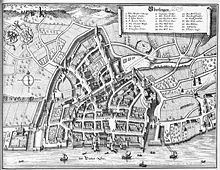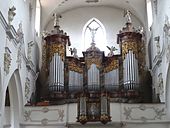Franciscan Church (Überlingen)
The Franciscan Church of the Immaculate Conception is an originally Gothic , later Baroque-style former monastery church of the Franciscan Convent in Überlingen . Like many other mendicant churches , it does not have a church tower , but only a small baroque roof turret . The church is located between Spitalgasse and Franziskanerstraße next to the Franziskanertor in the old town. It is the second largest church in the city after the minster St. Nikolaus , to whose parish it also belongs.
history

Franciscan nuns (known as “ Sisters on the Wies ”) have been in Überlingen since 1259, but could have been there since 1240, in the area of today's municipal cemetery outside the city wall ; The Holy Cross Church, which was demolished in 1529, was part of their settlement; they stayed at the old location on the " Wies " until the 16th century .
Brothers of the Franciscan Order founded in 1210 may also have been resident in Überlingen since 1240 , because in 1259 the Guardian of the Franciscan Order legally represented the sister in an act of donation. The Franciscans - also called " barefooted " - belonged to the Custody of Lake Constance of the Upper German or Strasbourg Order Province ( Provincia Argentina ).
In the year 1300 Elisabeth Countess von Königsegg donated a court to the Franciscans on the northern border of the inner city wall ring next to the city gate later called "Franziskanertor" to build a monastery . In 1308 another foundation for church building followed by Konrad von Schertweg. The three-aisled basilica was consecrated in 1348 by the Bishop of Konstanz , Ulrich Pfefferhard , expanded in the 15th century and the choir rebuilt in 1519/1520 . She bore the patronage of the Immaculate Conception of Mary . Numerous citizens had their graves in the monastery church or in the monastery cemetery; In addition to annual masses, the fees for this were an essential source of income for the monastery. The servants of the tailoring trade and later the tailors' guild had a common burial place in the church. The Sebastian Brotherhood of Crossbowmen and the Brotherhood of Bakers had their own altars in the church. The monastery was usually inhabited by ten to fifteen priests; in the 16th and 17th centuries it was repeatedly the seat of the provincial of Argentina or the custodian of the Lake Constance custody, and provincial chapters took place in the monastery several times . It was fully integrated into the life of the city and made its premises available for the elections of the mayor, mayor, the judges and part of the councilors and invited to various occasions for drinks and dinners.
The Überlingen monastery had appointments to collect alms in Ehaben, Meersburg, Mengen, Pfullendorf, Riedlingen, Saulgau, Schönenberg, Sigmaringen and Stockach.
During the Reformation , the monastery reading master came into conflict with the city council because he preached Lutheran while the council took an anti-Reformation position; the council expelled the reading master from the city and appointed secular priests as preachers. The economic situation of the convent deteriorated because they were banned from collecting alms and more and more funerals took place in a cemetery established in 1532 outside the city; In addition, the discipline in the monastery suffered, so that the superiors of the order province of Argentina had to intervene. In 1643 the Guardian was deposed for his economic management, in 1647 the parishes had to be abandoned and at the end of the Thirty Years War there were only four priests in the monastery. Around 1620, the Capuchins , brothers of the reform branch of the Franciscan Order, established in the 15th century, settled in Überlingen and built a monastery with a church ; they were soon more popular with the population than the Franciscans.
When in 1653 the council announced to the Provincial of Argentina that the Franciscan monastery would be transferred to the Jesuits for the establishment of a grammar school , in 1658 the Franciscans agreed to take over the grammar school. From 1675 they offered a degree in philosophy; as a result, however, the school had to be temporarily reduced to the lower classes. From 1742 to 1796 and from 1802 until the abolition of the monastery in 1808, all grammar school classes and philosophical studies were offered again. The city bore the costs of the school. The Franciscans built a new schoolhouse on their monastery grounds in 1712.
In the 17th century, the brothers also resumed scheduling three annual collections in a large district as far as the Danube, until Austria banned collecting in its area in 1782. 1604 was belt Brotherhood , 1680 a Antonius brotherhood and 1,736 cross Brotherhood. From 1700 to 1709 the convent buildings were rebuilt because of their poor structural condition, from 1752 until around 1766 the monastery church was made Baroque .
In 1808 the Franciscan monastery was secularized . The last Capuchins from Überlingen lived in the buildings until 1820 , as their monastery had been taken over by the House of Baden ; In 1817 there were four Capuchins, the last died in 1820.
This was followed by several changes of ownership between the Baden state and the city of Überlingen. The former monastery building serves u. a. as: elementary school , barracks , grand ducal district court and prison . In 1855 the Heilig-Geist-Spital zu Überlingen acquired the monastery and in 1857 it was relocated from today's landing site. A year later, the city and the hospital swapped the Franciscan church for the buildings on the landing site, which were then torn down. After a new hospital was built on the Mühlberg (today the St. Ulrich retirement and nursing home ) at the end of the 1880s, the hospital in the old monastery was converted into the St. Franziskus retirement home that still exists today . The church itself belongs to the city of Überlingen again and is used as a concert space in addition to church services . The last major interior renovation took place from 1975 to 1977 by the restorer Kneer from Munderkingen and by the Mezger art workshop in Überlingen. The last exterior renovation was in 1994.
Reconstruction from 1752
After extensive renovations and new constructions of the convent building in the years 1700 to 1712, the Franciscan church, which had been high-Gothic until then, was converted to Baroque style from 1752 according to plans by Johann Michael Beer . The nave received a new vaulted roof structure and was rebuilt in 1753 by the Constance court painter Franz Ludwig Herrmann , according to a fixed picture program, which u. a. provided a dummy dome , painted. A plasterer named Bantle did the rest of the work. The choir was rebuilt from 1754 and enlarged a little, the high, pointed-arched windows were "freed" of their tracery and divided into smaller ones. The Franciscan brother Sebastian Schilling from Villingen took on the painting of the choir room . The complete conversion from the Gothic to the Baroque monastery church was completed in the mid-1760s.
Furnishing
Little is known about the original interior of the Gothic Franciscan Church. The main altar from 1519/1520 is now in the city museum . Only two pieces of equipment still preserved in the church, a sculpture of John the Baptist from the first half of the 14th century and a life-size crucifix dated 1340/50 , bear witness to the original furnishings.
Altars
There are seven altars in the church since the renovation in 1752:
- The main altar (from 1754 and 1759), framed by four columns, shows the Virgin Mary as the patroness of the church, standing on a globe, crushing the head of a snake ( Immaculate Conception ). Next to her Adam and Eve , above her the Holy Trinity and at her feet the parents of Mary, Joachim and Anna . The Franciscan theologian Johannes Duns Scotus kneels at the edge of the picture . On the stucco marble columns there are white limewood sculptures of the two saints Laurentius and Stephanus . A canopy with a judgment angel rises above the altar . The main altar was created by the plasterer and sculptor Joseph Anton Feuchtmayer (with the assistance of Franz Anton Dirr) and the painter Gottfried Bernhard Göz , who both had been involved in decorating the nearby Birnau pilgrimage church a few years earlier . The main altar is also a double altar, the back of which ( called Chörle ) can be reached from the monastery building and consists of a carved relief image .
- To the left of the choir arch is the Bonaventure altar and to the right of the arch is the Johann Nepomuk altar (both from 1763).
- The two altars Franziskus and Antonius von Padua (both from 1764) stand at the respective front sides of the two aisles.
- The Sebastian altar on the long wall of the northern nave is a foundation of the Sebastian Brotherhood from 1766.
- Opposite on the southern side is the baker's altar as a foundation of the Überlingen bakers' guild from 1763.
All of the mentioned side altars, as well as the pulpit from 1761, come from the sculptor and collaborator Feuchtmayer, Franz Anton Dirr.
organ
The original organ , of which only the case has survived, was built in 1755 by the organ builder Johann Georg Aichgasser from Überlingen . Several renovations and new buildings followed. Today's organ was completed in 1958 by Xaver Mönch .
|
|
|
|
|||||||||||||||||||||||||||||||||||||||||||||||||||||||||||||||||||||||||||||||||||||||||||||||||||||||||||||||||||||||||||||||||||||||||||||||||||||||||||||||||||||||||
literature
- Marion Harder-Merkelbach, Michael Brunner (ed.): 1100 years of art and architecture in Überlingen (850–1950). Book accompanying the exhibition at the Städtische Galerie Überlingen. Imhof Verlag, Petersberg 2005, ISBN 3-86568-032-1 .
- Ernst Auer: The Franciscan Church in Überlingen, for the 600th anniversary of its inauguration, 1348–1948. August Feyel, Überlingen 1948.
Web links
Individual evidence
- ↑ history of the monastery at kloester-bw.de
- ↑ kloester-bw.de Franciscan Monastery Ueberlingen - history.
- ↑ kloester-bw.de Franciscan Monastery Ueberlingen - history.
- ^ Website of the Münster community
- ↑ St. Franziskus on the website of the Münster community in Überlingen
- ↑ Further information and disposition of the organ on OrganIndex
Coordinates: 47 ° 46 ′ 4.8 " N , 9 ° 9 ′ 33.9" E






